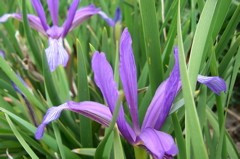
Salvia mexicana 'Limelight'
One of my favourite salvias, which always looks great in the autumn. The flowers are lime-green and in exhuberant clusters like something tropical. Responds well to good soil.


Choice evergreen Iris from Greece and Turkey with blue flowers like Iris reticulata. Our stock plants grow well in a sunny south-facing rockgarden.
Choice evergreen Iris from Greece and Turkey with blue flowers like Iris reticulata. Our stock plants grow well in a sunny south-facing rockgarden.
Data sheet
One of my favourite salvias, which always looks great in the autumn. The flowers are lime-green and in exhuberant clusters like something tropical. Responds well to good soil.
A useful pond side plant or for wet soils, where it will form a dense ground cover. Bright green leaves and red flowers during summer.
Unusual deciduous violet with purple flecked flowers, likes leafy moist soil in shade.
A terrific subulata ground covering variety, hundereds purple flowers in spring an a good groundcovering habit, likes some drainage but not overly fussy and can tolerate drying out in summer..
Deep cobalt-blue flowers on tall stems. Delphiniums love horse manure and require sheltered sunny conditions to do their best.
Sculptural rosette forming succulent, attractive in a pot, border, or rock garden setting. Prefers part shade during really hot periods, otherwise drought hardy. Wild populations now endangered so please nuture these in your garden.
Rose pink variety, useful infill under David Austin roses and amongst spring perennials.
A perennial grass with fine silvery green foliage, colouring bronze in autumn. The flowers and seedheads are an attractive fan shape. Clumping and non-invasive.
Very pretty pale pink variety, mounding habit a bit over knee high for sunny position on drained soil. Trim after flowering to keep compact.60
Papaver Choir Boy produces beautiful white poppies with black central blotches, grow in fertile moisture retentive clay based soil and allow to dry out over late summer. Not for pots.
Tall white phlox with delicious perfume, flowering in summer. Best in fertile conditions protected from afternoon sun.
Outstanding grey foliage plant for rock garden, border, or mass planting. Contrasts well with colourful foliage like berberis and cotinus, or in combination with Salvia nemorosa varieties. Yellow button flowers through summer, trim off if not your colour scheme!
An attractive variety with tangerine to red single flowers, we love these for summer colour with rudbeckia, sedums and echinacea.
A brilliant low grass with outstanding flowers and seedheads, suitable for massed foreground plantings in landscape design work or in clusters amongst other perennials. A slender plant so plant closely at 25cm for best results. Not self seeding in our trial stockbeds.
Spreading species from Korea with large white bells speckled pink. Attractive glossy foliage.
Long flowering agastache great for attracting butterflies into the garden. Summer flowering and one of the better agastache we have trialled, fertile loamy soil best, and will tolerate some clay if worked and mulched. We find these will only tolerate light occasional frost.

Choice evergreen Iris from Greece and Turkey with blue flowers like Iris reticulata. Our stock plants grow well in a sunny south-facing rockgarden.